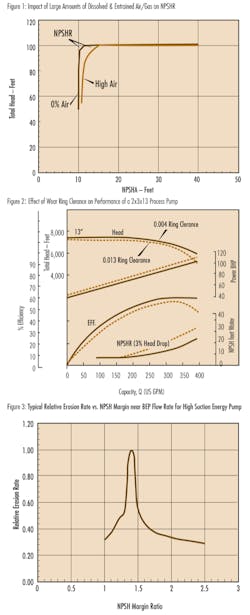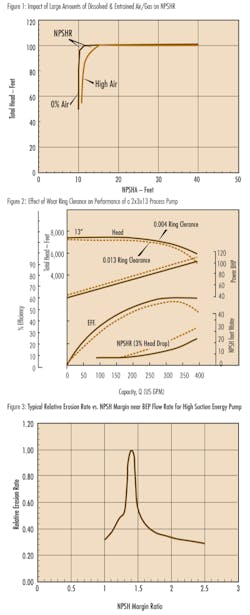Pump NPSHR and NPSH Margin Uncertainties
By Allan R. Budris
Several of my past Pump Tips columns have discussed the impact of Suction Energy, NPSH Margin Ratio, air and suction recirculation on pump cavitation and cavitation damage. However, it is difficult to obtain the true value of the NPSH Margin Ratio, which is defined as the NPSHA (available) divided by the NPSHR-3% (required). This is primarily due to the many uncertainties involved in determining the actual value of the NPSHR-3% (required), which will be discussed below. The other NPSH margin component, the NPSHA (available), also has some of its own uncertainties which will not be covered. NPSHR uncertainty is one of the reasons why reliably focused pump users provide sizable NPSH Margins for critical applications, especially those involving "High Suction Energy" pumps.
The following factors create uncertainties (potential differences) between the factory provided and actual field installed NPSHR(3%) values.
- The method used to determine the factory NPSHR has a definite impact on the accuracy:
- An Actual NPSH factory test of the specific pump, tested in accordance with the Hydraulic Institute Standard (ANSI/HI 1.6), conducted at the rated speed, and impeller diameter. This is the gold standard, but even this test method is subject to test fluctuations and instrument accuracies, which could be in the range of ±2.5% to ±5%, depending on the accuracy of the instrumentation and the air content of the test liquid.
- A Hydraulic Institute NPSH test of a similar model and size pump (Price Book Curve). Generally the uncertainties of this method would be expected to be greater than for a test of the actual pump (probably in the range of ±5% to ±15%), due to the following potential differences between the specific pump and the pump used for the price book curve.
- Impeller wearing ring clearance: A greater clearance than tested increases the wearing ring leakage, and thus the NPSHR of a pump by increasing the gross flow through the impeller eye, plus disturbing the incoming flow stream. The impact of this effect is not large with new pumps (within the manufacture's tolerance range), but can be quite large (up to +50%) as this clearance opens (wears) with extended field operation.
- The thickness of the leading edges of the impeller vanes (or impeller eye diameter): The cast vane thickness will vary from one impeller to the next, with the amount of variation dependent on the casting method used. Thicker vanes (or smaller impeller eyes) cause more blockage which increases the inlet velocities and, therefore, the NPSHR of a pump.
- Any difference between the factory test and field application pump speed. The NPSHR does not always exactly follow the scaling (square) law when factoring to another speed.
- Any difference between the factory test impeller diameter and that of the application. The NPSHR is not just a function of the flow rate, but can also change based on the impeller diameter, since it is a function of the discharge head drop (3%).
- A Hydraulic Institute NPSH test on a (smaller) model pump, if testing of the full size pump is not feasible. The accuracy of this method would not be expected to be as good as the results from a full size similar pump (since scaling errors are also introduced). The accuracy of this method would be expected to be in the range of ±7% to ±18%.
- Another method for determining the NPSHR of a pump, with reasonable accuracy, would be the use of a Computational Fluid Dynamics (CFD) computer program, such as the ANSYS CFX software. The accuracy of this method would be expected to be less than for actual controlled factory tests, and probably similar to a model test, since not all physical factors can be accurately modeled. The accuracy of this method would be dependent on the software used (has it been specifically modified for NPSH evaluation); the degree and similarity of its calibration against actual test results; the size of the computer used (a powerful computer is required, especially if the suction piping is to be included in the analysis); and the proficiency (experience) of the program operator. The accuracy of this method would likely be in the ±7% to ±18% range.
- Finally, an NPSH field test using calibrated instruments (with proper straight runs of piping before and after the instruments) could be conducted. The field conditions would, however, have to allow for the throttling of the suction pressure and changes to the flow rate; plus have a means to accurately measure the flow rate. In some respects this could be the most accurate test, since all specific field conditions would be included in the test results. The accuracy of this method is strongly dependent on how closely the test conditions follow the Hydraulic Institute test criteria. A fair estimate of the accuracy of this method would probably then be in the ±2.5 to ±30% range.
- There are also field conditions that further impact the accuracy of predicting the installed pump NPSHR(3%), such as:
- Actual field pump speed: As mentioned above, the NPSHR basically varies with the square of the pump speed, which does change slightly with changes in the motor slip, even at the same nominal speed. Operation at less than the full rated motor power, and/or high efficiency motors tends to reduce the motor slip. This can cause the pump to operate at slightly higher speeds in the field, compared to a factory test with the factory calibrated motor, which could increase the NPSHR from 0% to about 1%.
- The temperature of the Liquid impacts the NPSHR of a pump. As the water (pumped liquid) temperature increases, the size of the cavitation vapor bubbles generated get smaller, thus creating less blockage. At a water temperature of 210 degrees F, the NPSHR value will be reduced by about 1 foot, compared to ambient conditions. This effect actually provides a small positive variation in the actual NPSH margin.
- Using insufficient lengths of pump suction piping (after a disturbing fitting), in the field can impact the pump NPSHR. Straight inlet pump pipe lengths, less than those shown in the April 2009 Pump Tips column, could increase the pump NPSHR due to disturbances in the inlet flow stream. Non-uniform flow generates higher local velocities in a pump inlet, which causes lower local static pressures, and thus more liquid to flash into vapor, which would increase the NPSHR. This affect is the greatest when the pump is operating in the suction recirculation region. This is where a good CFD analysis, or field test would benefit.
- The air content of the test liquid: Entrained air or gas/vapor can have a detrimental effect on the suction performance of a pump. Air or gas will expand as the static pressure is reduced in the inlet of the impeller, thus blocking the liquid flow through the impeller, much like the blockage from cavitation vapor bubbles, which cause a decay in the pump discharge pressure. The net result is an increase in the NPSH requirement (NPSHR) of the pump. Figure 1 gives an example of how air will increase the NPSH performance of a pump. Pump damage will, however, probably be reduced due to this increased air.
- Pump wear: As mentioned above, this is an important factor that can have a marked impact on the pump NPSHR, due to the added flow (leakage) into the pump inlet, and flow disturbance from the opening up of the pump wearing rings, as shown in figure 2. This example shows how the various performance parameters of a low specific speed pump can change due to the wear (opening up) of the impeller wearing ring clearances. In this case, the NPSHR increases by 0% to 30% (depending of the flow rate), due to a four-fold increase in wearing ring clearance. The actual impact of wearing ring leakage on a specific pump is determined by the amount of wearing ring wear, the flow rate (as a percent of best efficiency flow), and the Specific Speed of the pump. The NPSHR of a high specific speed pump will be affected less by wearing ring wear (since the leakage is a smaller percentage of the net pump flow), compared to a low specific speed pump, which has a lower flow and higher pressure which causes more leakage. The NPSHR impact for all specific speeds is normally greatest at the highest flow rates.
In conclusion, due to the above uncertainties in determining the true NPSHR of an installed pump, even a low suction energy pump should have an NPSH Margin of at least 10% to 20% above the factory NPSHR value, for good reliability. High suction energy pumps should have NPSH margins of at least 50% (see figure 3) and Very High suction energy pumps should have NPSH margins of 100% or higher. These recommended uncertainty NPSH margins apply to flow rates above the start of suction recirculation. Much higher NPSH margins are required when high suction energy pumps are operated in the suction recirculation flow region.
WW
References:
1. "Effects of Entrained Air, NPSH Margin, and Suction Piping on Cavitation in Centrifugal Pumps", by Allan R. Budris & Phillip A. Mayleben, Proceedings of the 15th International Pump Users Symposium, March1998
About the Author: Allan R. Budris, P.E., is an independent consulting engineer who specializes in training, failure analysis, troubleshooting, reliability, efficiency audits and litigation support on pumps and pumping systems. With offices in Washington, NJ, he can be contacted via e-mail at [email protected].
More WaterWorld Current Issue Articles
More WaterWorld Archives Issue Articles

